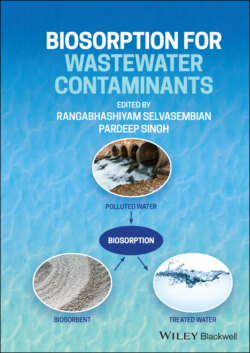Читать книгу Biosorption for Wastewater Contaminants - Группа авторов - Страница 32
Yeasts as Biosorbents
ОглавлениеYeasts are single‐celled organisms in which the bulk of the biomass either biosorbs a wide range of metals or is selective for a single metal ion. Yeasts also possess a high potential to accumulate and, as a result, can be utilized as biosorbents to absorb heavy metals. Saccharomyces cerevisiae is a model organism for biosorption research. They remain non‐pathogenic and easy to cultivate, and they produce a large amount of biomass using a basic growing media (Gaensly et al., 2014). Biosorption properties of yeast were studied using various forms, including free vs. immobilized cells, dead vs. live cell, engineered vs. non‐engineered cell, etc. (Park et al., 2003). The yeast cells in free form are not suitable for biosorption as there is a problem in solid‐fluid phase separation. In flocculating cells, this problem tends less effective (Veglio and Beolchini, 1997). Yeast cells must be pretreated to increase the surface‐to‐volume ratio of metal binding sites (Mapolelo, 2004).
Table 2.3 Biosorption of heavy metals by different fungi.
| Fungal biomass (biosorbent) | Metal ions (biosorbate) | Functional groups | References |
|---|---|---|---|
| Pleurotus ostreatus | Chromium | Carboxyl, amine groups | (Arbanah et al., 2013) |
| Hydrilla verticillata | Cadmium | Carboxyl, hydroxyl, amine groups | (Acosta Rodríguez et al., 2013) |
| Aspergillus terreus | Copper | Carboxyl groups | (Gulati et al., 2002) |
| Trametes versicolor | Nickel | Carboxyl, hydroxyl, amine groups | (Subbaiah and Yun, 2013) |
| Penicillium chrysogenum | Arsenic | Carboxyl, amino groups | (Mamisahebei et al., 2007) |
| Phanerochaete chrysosporium | Lead | Hydroxyl, amino groups | (Haluk Ceribasi and Yetis, 2004) |
| Pencillium simpliccium | Zinc | Carboxyl, amino groups | (Fan et al., 2008) |
| Aspergillus fumigatus | Mercury | Amino, hydroxyl groups | (Mamisahebei et al., 2007) |
Different parameters of metal ions such as valency, diameter, cell age, culture conditions, concentration of metals, temperature, and pH influence the process of biosorption (Wang and Chen, 2006). Biosorption involves amino, carboxyl, and hydroxyl functional groups. The isothermal model of Langmuir was better adapted to a biosorption ion exchange mechanism (Luo et al., 2010). Yeasts’ huge size, on the other hand, makes them potential candidates for metal bioremediation. Table 2.4 lists the many yeast strains utilized in biosorption.
